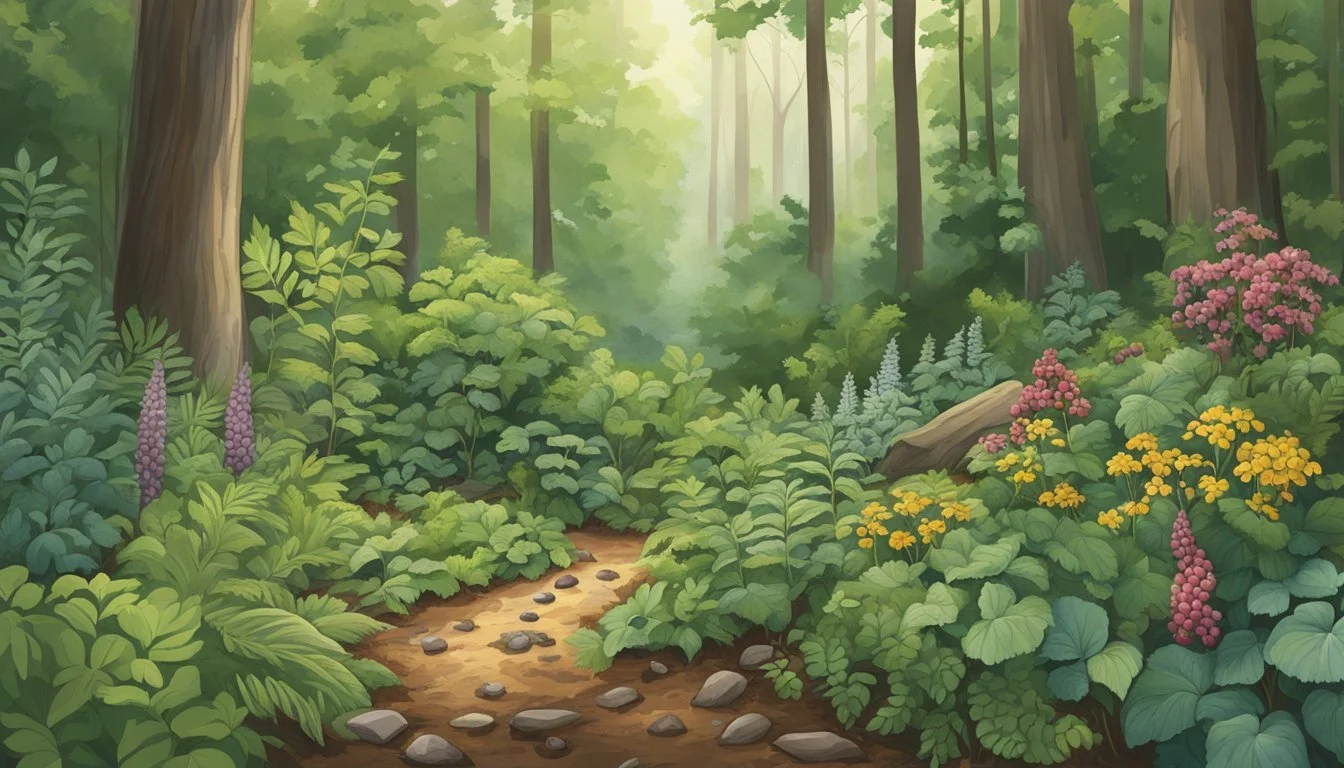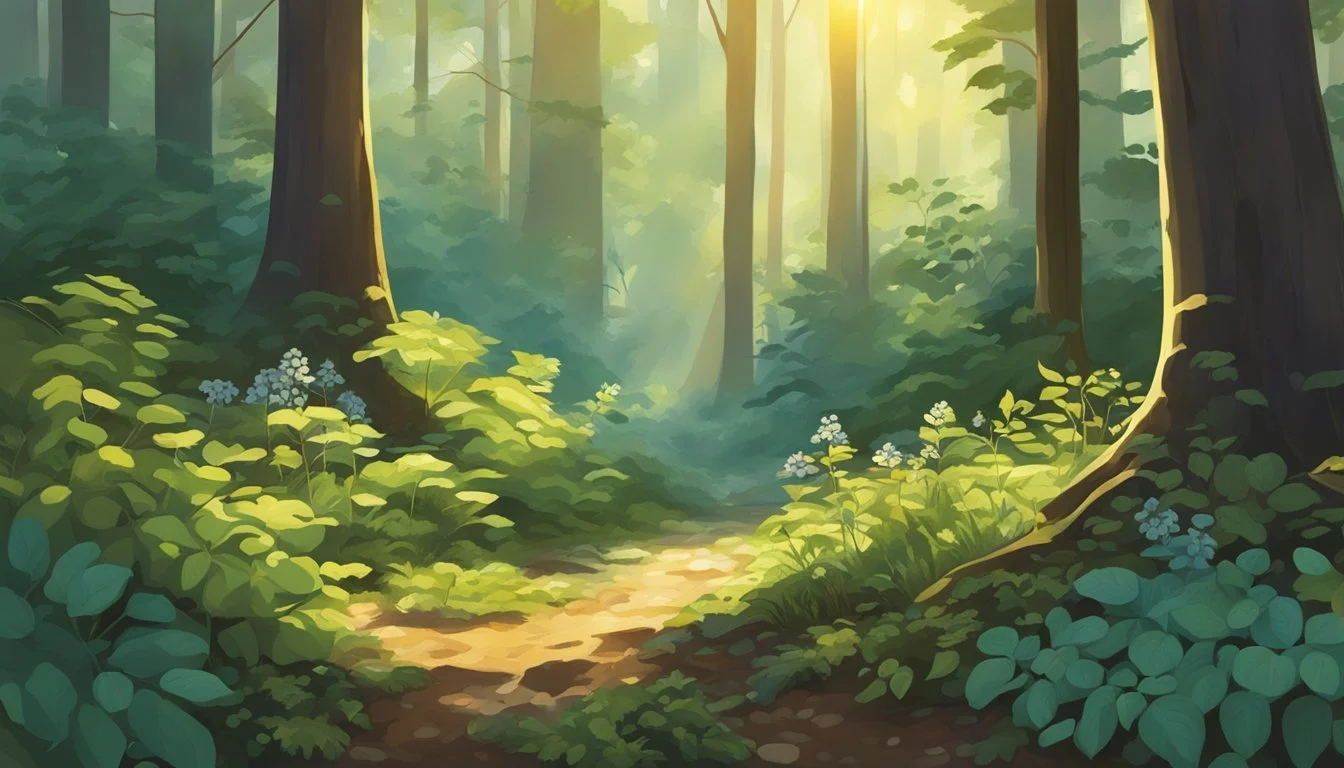Native Edible Plants in Arkansas
A Guide to Foraging Local Flora
This Article is Part of Foraging Guide for All 50 US States
Arkansas offers a rich tapestry of native edible plants, reflecting the state's diverse ecosystems ranging from the Mississippi Delta to the Ozark and Ouachita Mountains. These plants have formed a vital part of the regional diet for centuries, if not millennia. For modern foragers or those seeking to incorporate more wild foods into their meals, Arkansas's natural bounty presents ample opportunity. From leafy greens to fruits and nuts, the state's flora provides both nutrition and a connection to the land.
Foraging in Arkansas requires knowledge of plant species, growth patterns, and harvesting seasons. Edible plants such as pawpaw, persimmon, and various species of berries ripe for the picking are distributed across the state’s forests and fields. These plants not only offer sustenance but also have played a role in the cultural heritage of the region, with many being used by Native American tribes and early settlers.
Identifying these plants correctly is crucial for safe foraging. It's important for individuals to familiarize themselves with the appearance of edible plants and their toxic look-alikes. Resources like local foraging workshops, field guides, and knowledgeable community members are valuable for gaining this expertise. Through responsible foraging practices, one can enjoy the flavors of Arkansas's native plants while maintaining the ecological balance of the habitats they grow in.
Interested in Mushroom Hunting in Arkansas?
Arkansas' lush forests and diverse landscapes provide excellent opportunities for mushroom hunting. From the Ozark Mountains to the Mississippi River Delta, the state is home to edible species like morels, chanterelles, and hen of the woods. With proper identification skills and respect for public and private land regulations, foraging in Arkansas promises a rewarding adventure.
👉 Guide on Mushroom Hunting in Arkansas
Understanding the Foraging Landscape in Arkansas
Arkansas offers a diverse range of edible plants, and understanding its foraging landscape requires knowledge of the state's varied climate and habitats. Safe and ethical foraging is rooted in respect for laws, ecology, and the history of land use in the region.
Climate and Seasons for Foraging
Arkansas's climate is conducive to foraging nearly year-round. Spring brings tender greens and flowering plants, while fall is known for a bounty of nuts and fruits. Seasonal changes significantly affect what is available for foraging in woods, forests, and other natural areas.
Natural Habitats and Foraging Locations
Arkansas is home to diverse habitats ranging from dense forests to open forest edges. Foragers will find different species under the canopy of trees, in wooded areas, and near streams. Wildlife such as deer, birds, and insects thrive here, indicating a rich ecosystem with plentiful foraging options.
Legal and Ethical Foraging Practices
Foragers must always seek permission before gathering plants, especially on private property or near highways. Taking only what is needed for entertainment purposes, leaving plenty for wildlife and future growth, is a cornerstone of responsible foraging. It's essential to follow Arkansas's foraging regulations to uphold ethical standards.
Foraging Safety and Identifying Toxic Lookalikes
Caution is vital when foraging, as many edible plants have toxic lookalikes. Foragers should seek expert advice and use resources such as websites and field guides to accurately identify plants. Misidentification can lead to serious health risks.
Foraging Equipment and Resources
Effective foraging requires minimal but specific equipment, including durable containers, gloves, and possibly a foraging tool like a knife. Resources are abundant; websites and field guides provide invaluable information to both novice and experienced foragers.
Historical Context of Foraging in Arkansas
The practice of foraging in Arkansas is steeped in history. Early settlers and Native Americans relied on nature's bounty for survival. Today, foraging continues as a connection to the past, allowing individuals to engage directly with the land and learn from its natural abundances.
Seasonal Foraging Guide
In Arkansas, the forager can find a diverse range of native edible plants throughout the year. This guide provides a seasonal look at when and what to forage.
Spring Edibles: Greens and Early Blossoms
In early spring, dandelions emerge, offering their leaves for salads and yellow flowers for syrups. One may also find tender greens such as wild violets, which provide both edible leaves and flowers. As the season progresses, look for the blossoms of redbud trees, which can be eaten fresh or pickled.
Summer Bounty: Berries and Fruits
By early summer, the bushes and brambles flourish with erriewilds. Both blackberries (how long do blackberries last?) and mulberries can be harvested. One must be quick to gather these fruits as animals also favor them. Come mid-summer, one can find muscadines and beauty berries, the latter being identifiable by their distinct clusters of iridescent purple berries. For those familiar with the sharp taste, juniper berries (how long do juniper berries last?) from native juniper trees can be a unique find.
Autumn Harvest: Nuts and Late-Season Plants
During early fall, trees such as the white oak drop their acorns, which can be processed into flour (how long does flour last?) after leaching their tannins. Black walnuts (how long do walnuts last?) and hickories provide rich-tasting nuts. The fruits of persimmon trees and pawpaws are ready to harvest when they yield to slight pressure, bearing a custard-like flavor. This is also a prime time for foraging wild seeds and mushrooms, though one must be sure to properly identify these as many can be toxic.
Winter Finds: Evergreens and Hardy Varieties
In the winter months, foragers can target evergreen plants like the eastern white pine, which provide vitamin C packed needles that can be used to brew tea. Also, the resilient pawpaw can sometimes hold onto its fruit into the early winter, if not yet taken by wildlife.
Most Popular Edible Plants and Their Uses
In Arkansas, a variety of native plants offer both nutritional value and versatility in culinary applications. This section explores the most popular edible plants and how they can be utilized, from raw consumption to complex recipes.
Wild Berries and Preparation Methods
Wild berries in Arkansas, like muscadines (Vitis rotundifolia) and various other brambles, are abundant. These can be eaten fresh, but are often used to make jams, jellies, syrup, and pies. To make a basic berry jam:
Crush the berries.
Measure and mix with equal parts sugar.
Boil until it reaches the desired consistency.
Remember to strain seeds if preferred, especially when dealing with muscadine grapes.
Nuts and Seeds: From Gathering to Processing
Oak trees yield acorns, which contain tannins that must be leached before consumption. Once leached, acorns can be ground into flour or meal. Furthermore, black walnuts provide a rich flavor to dishes and are used in recipes from ice cream to savory entrees. Harvest nuts in autumn, and dry or roast them for storage.
Leafy Greens and Flowers: Diverse Culinary Applications
Leafy greens and flowers from plants like dandelions are more than just a salad addition; they can be cooked down as greens or used fresh. The flowers also make a pleasant addition to drinks and can be used to infuse water or vinegar. A simple use is:
Add flowers to mixed greens for a salad.
Use the greens to make a nutritious tea.
Fruits: Preserving and Cooking
Arkansas-native pawpaws and persimmons are treasured fruits that can be made into desserts like cobbler and ice cream, or preserved as jams and jellies. Persimmons, when fully ripe, are sweet and can be used to make a unique lemonade. Pawpaws have a creamy texture and a tropical flavor, suitable for custards (how long do custards last?).
Other Uses: Beyond the Kitchen
Plants like sumac berries (Rhus glabra) are not just for culinary uses but can be made into a tea or a coffee substitute due to their lemony flavor. Their seed cone, rich in chemicals, can be used as a natural dye or for medicinal purposes, often found in wooded areas.
Incorporating Wild Edibles into Your Diet
Wild edibles in Arkansas offer unique flavors and nutritional benefits. Foraging can enrich your diet with a variety of species packed with antioxidants and dietary fiber.
Health Benefits and Nutritional Information
Wild edible plants found in Arkansas often contain higher levels of vitamins and minerals compared to cultivated varieties. For instance, dandelion greens are laden with vitamin C and antioxidants, while wild strawberries are a rich source of dietary fiber and vitamin C. Incorporating these species into your diet can contribute to a healthy and nutritious lifestyle.
Simple Foraged Recipes and Pairings
Salad: Toss young chickweed or violet leaves with a light vinaigrette for a nutrient-rich salad.
Tea: Brew pine needle tea for a dose of vitamin C and a soothing, mild flavor.
Jams and Jellies: Create blackberry jam or elderberry jelly to capture the sweet and slightly bitter undertones of Arkansas' native fruits.
Syrup: Simmer hickory bark to produce a smoky, rich syrup perfect for pancakes or waffles.
Creative Culinary Experiments with Wild Plants
Culinary experimentation with wild edibles can lead to unique and satisfying dishes. Try adding sassafras leaves to thicken soups or stews, or bake a wild persimmon pie for a twist on traditional desserts. Fiddlehead ferns can be sautéed for a distinctive side element. Each experiment enhances familiarity with the diverse flavors of native plants.
Maintaining a Balanced and Sustainable Diet
When foraging, it's crucial to maintain a balanced diet and ensure sustainable harvesting practices. Rotate the species you consume to get a broad range of nutrients and to avoid overharvesting a particular plant. Remember to only take what you need and to forage in areas free of pesticides and pollutants.




